Dobar Dan! Today we are talking about Tomatoes!
Note: I have been on a hiatus with my blog, but it is time to start writing again. My last entry was about going to America (and not to vote!). Anyway, thanks to that blessed trip abroad, I was able to transfer my US driver’s license to a Croatian license, and now the world is my oyster. Public transportation notwithstanding, it sure is nice to be independent.
Based on your comments, If there is any interest about transfering one’s driver’s license, I can gladly write about transfering documents sometime in the future, so let me know!
In this post I will share with you:
Delicious ways to use fresh Tomatoes –
What types of Tomatoes are best for which foods,
and, if you are really ambitious, some starter tips for
Growing Tomatoes!
(There a surprise at the end!)
Since tomatoes are in their glorious season, it will be today’s topic. It is not an exaggeration to say that Tomatoes are (cross my heart) one of the main reasons I decided to extend my summer holiday and eventually stay in Croatia.
Tomatoes’ official Croatian name – Rajčica – meaning heavenly fruit. They are also called Pomedore on the coast, meaning Golden Apple (and a golden ring is visible on the very top from its original yellow flower). I’m from Los Angeles so all this stuff is pretty amazing to me, even now 🙂 🙂
To make homemade salsa, best to use over-ripe tomatoes, mixed in a food processor with onion, chili (I use Fereroni) and garlic for dipping with tortilla chips. You can also freeze ground up tomato salsa (without the chilis) into yogurt bottles, for future use in wintertime recipes.
Growing Tomatoes
Don’t be deceived – we don’t grow them to save money – rather to eat, enjoy, and perhaps brag a little “these are my domaće (home grown) pomedore (tomatoes)!.
There is really no substitute for fresh, home grown, ripe and red tomatoes, juicy and tangy and sweet all at the same time. It is possible to find decent tomatoes in Croatia and abroad. The worst case scenario is a finding a nice looking tomato in the store to later discover its grainy, rose colored innards that seem to be a cross between plastic and cardboard. That’s why I do the work – it is worth it.
1.The Prep work
Till the soil – hire someone to use the roto tiller to prepare the land for planting. Add fertilizer – a synthetic one called KAN is often used (like, I can, I can successfully groww Tomatoes!),
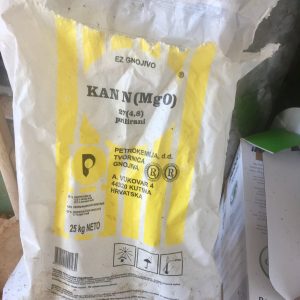
but if possible, sheep manure is great for nourishing the soil, to be mixed with the existing soil. Make straight rows, ideally by pulling a string and from one end to another to ensure that you dig in a straight line. Remove all visible weeds and grass, they will only antagonize your crop. Tomatoes should be planted in as much direct sunlight as possible, not too close nor too far together so you can walk between the rows.
2. Planting
Wearing gloves, place each tomato plant into the ground about 10 inches apart, and pile a mountain of loose dirt around it for protection. It helps to actually talk to the plant. Once all the plants are in the ground, fill up any loose dirt and administer water – two or three times so they will have a smoother transition. I add the support poles a day or two later.

Bamboo shoots or other wooden sticks are inserted near the plant and as it grows, the plant is tied to the stick for support. I used string or yarn at first, but there is a special greenish plastic tape at the nursery store for this – it is rain resistent.
3. Maintenance
Plan to dedicate some time in the beginning, and then – a few hours a week for maintenance – loosely digging around each plant so that light and air get to the roots; watering and tying up the growing tomato stalk as it grows.
Water every day if possible, a little or a lot depending on the weather. Methods: 1. A water irrigation system known as “kap na kapi” (droplet by droplet on your precious plants) – it is hooked up to your hose and can be bought at the nursery.
Take a bucket or use the hose in the early morning / late evening and administer the water by hand (which ends up being costlier because it is less efficient) – your mission, if you choose to accept it, is to keep them alive.
In general, tender loving care will reward you with a wonderful tomato crop. I am still not an expert but I feel like I am starting to get the ABCs of it down.
What
The plant seedlings can be purchased in the open market or the nursery for 3-4 kuna a piece (at time of print, $1.00 = 6.65 kunas), and, more is better, especially if you really love tomatoes.
When
Tomatoes are planted in March or April, depending on the weather, and use sticks to keep them from becoming too top heavy. Paprika are also planted around the same time – they compliment one another.
How
Some TOMATO EXPERTS tie two poles, bamboo or otherwise, into an inverted V and the two plants grow up along the poles, you have to tie them as the stalks grow. If you decicide to Grow Tomatoes in Pots the water stays with the plant in the tray below and they can actually thrive better than those placed in the ground. Here only one stick or pole is necessary.
Some Types of Tomatoes (see above!)
Sljiva – plum tomatoes (also known as Roma Tomatoes) – less juicy and good for making sauce
Cherry tomatoes – sweet – and especially nice in salads
Beefsteak tomatoes (big and round)
Wolf heart tomatoes (they are heart shaped) – my personal favorite
Some Favorite Uses for Tomatoes!
RAW:
My favorite salad is the traditional tomato and cucumber salad which can be mixed together paprika, onion of any type (white, lavendar or with a few green shallots) and an olive oil, salt and pepper dressing. Really delicious, especially with barbecued fish, meat or chicken.
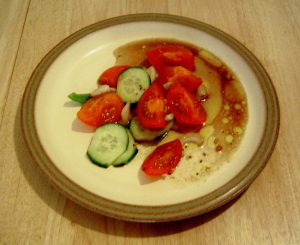
- Even more simply, just slice up a tomato, add salt, oregano and a little home made olive oil – mm.
- Rikula – arrugola in Italian – is a peppery green leafy addition that creates an opposites attract combination with the tomatoes.
- Fresh tomato salad with cottage cheese
- Another great salad – caprese – is made with mozzerella cheese slices, tomatoes, and basil – fantastic, especially with balsamic vinegar, but only a touch, because the tomatoes have their own acidity.
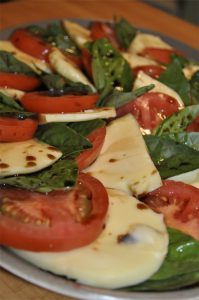
COOKED:
Tomato salsa (with or without meat): Sauteed in this order: finely diced onion, garlic, parsley (garlic and parsley can be chopped up together), Meat, if desired, oregano, basil and tomato solids (ie without seeds or skin). Add 1T sugar and season to taste. Store and freeze when cool.
We also make something called Pasticada (pah-stih-saah-daah) which usually has meat in it, but is slow cooked over a low fire and drizzed over njoki, rice or noodles. Well this week I found out a new use for pasticada.
Mr Amerikanka in Croatia is a performer, so he returns late at night. The next morning I noticed that the windshield of our car had the remnants of a pasticada rainstorm – oh my, what happened here?
It turns out that the grouchy old lady in his colleague’s apartment complex threw pasticada from her balcony on his and another band member’s autos as a warning to not park here again. Now that’s something new..
BONUS:

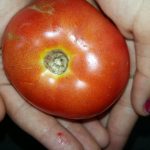
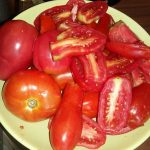
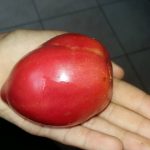
Recent Comments